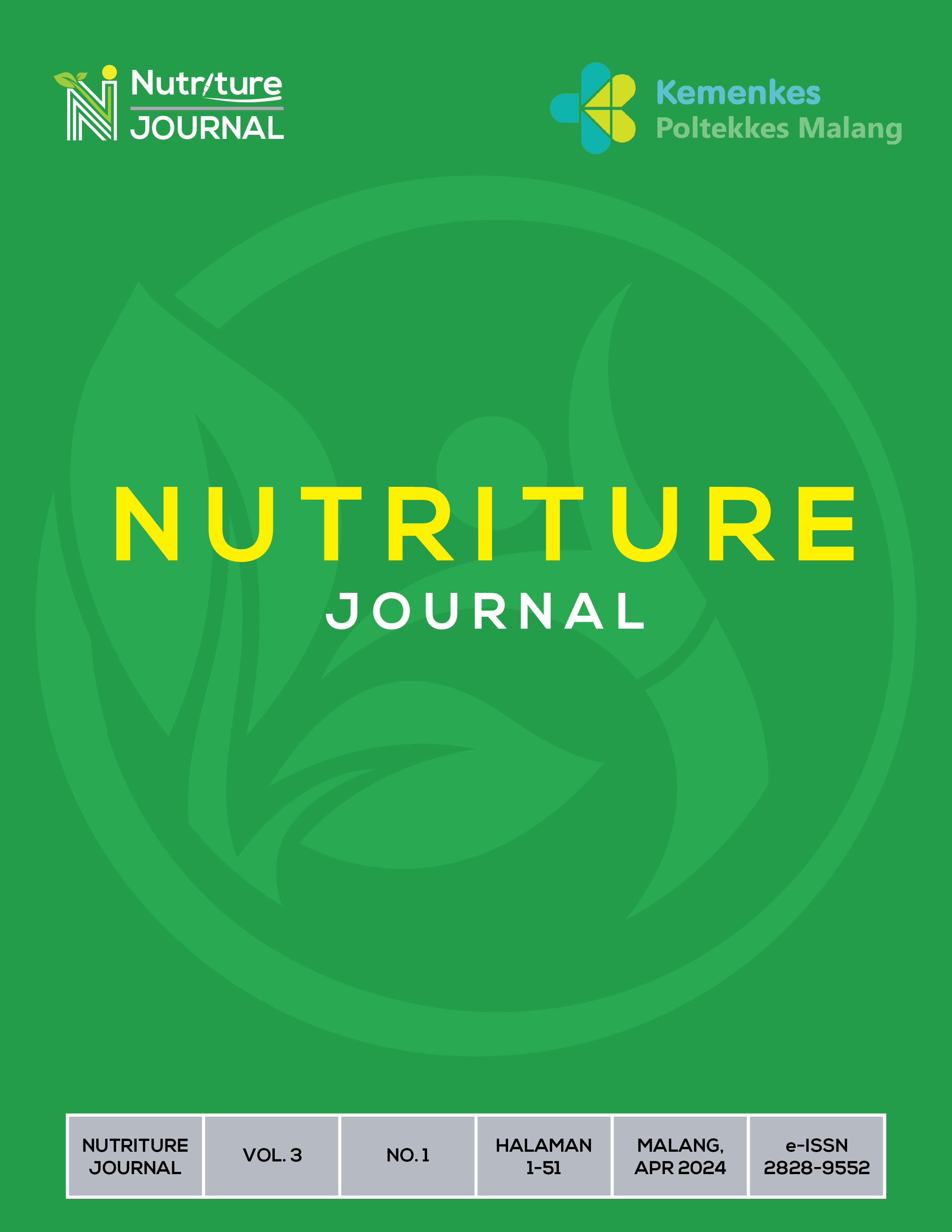Gambaran Asupan Zat Gizi Makro dan Status Gizi Ibu Hamil di Wilayah Puskesmas Parit Mayor Kecamatan Pontianak Timur Kota Pontianak
DOI:
https://doi.org/10.31290/nj.v3i1.4298Kata Kunci:
ibu hamil, zat besi, asupan zat giziAbstrak
Background: Chronic Energy Deficiency (CED) refers to a condition in which a pregnant woman experiences prolonged insufficient food intake, resulting in various health disorders for both the pregnant woman and the developing fetus. The consequences of CED can have negative impacts on the health of the mother and the growth of the fetus. The pregnancy phase is considered a critical period that significantly influences the future quality of human life. Based on Riskesdas data, the proportion of CED risk in pregnant women in West Kalimantan in 2018 reached 13.9%. Objective: To determine the Overview of Macronutrient Intake and Nutritional Status of Pregnant Women in the Parit Mayor Health Center Area. Method: This study utilized a descriptive research design with a cross-sectional approach. The study sample consisted of pregnant women in the Parit Mayor health center area, and the variables examined included nutritional status and macronutrient intake. Univariate analysis was employed. Results: The research findings revealed that the nutritional status of pregnant women based on anthropometry, measured using Mid-Upper Arm Circumference (MUAC), showed a normal category in 68.3% of cases, while 31.7% were categorized as having Chronic Energy Deficiency (CED). Energy intake was insufficient in 58.5% of cases, adequate in 41.5%, protein intake was adequate in 46.3%, insufficient in 29.3%, and excess in 24.4%. Fat intake was insufficient in 61.0%, categorized as adequate in 31.7%, while carbohydrate intake was insufficient in 85.4%, and adequate in 14.6%. Conclusion: Based on the research findings, the majority of pregnant women demonstrate normal nutritional status according to LILA anthropometric measurements with adequate protein intake, although energy, fat, and carbohydrate intake appear to be insufficient.
Keywords: Pregnant Women, Nutritional Status, Nutrient Intake
Referensi
Alza, Y. (2018) ‘Hubungan Asupan Energi Dan Paritas Terhadap Resiko Kek (Kekurangan Energi Kronis) Pada Ibu Hamil Di Kecamatan Payung Sekaki Kota Pekanbaru’, Jurnal Proteksi Kesehatan, 4(1). doi: 10.36929/jpk.v4i1.32.
Anggraeni, F. D. (2019) ‘Analisis Faktor yang Berhubungan dengan Kejadian Kekurangan Energi Kronis (KEK) di Wilayah Kerja Puskesmas Kasihan I, Bantul Yogyakarta.’, Jurnal Ilmiah Kesehatan Rustida, 6(2), pp. 671–679. doi: 10.55500/jikr.v6i2.82.
Apriliani (2016) Hubungan Asupan Zat Gizi Makro (Protein, Lemak, Dan Karbohidrat) Dengan Lingkar Lengan Atas (Lila) Pada Ibu Hamil Di Wilayah Kerja Puskesmas Sawah Lebar Kota Bengkulu Tahun 2016, Poltekkes Kemenkes Bengkulu.
Azizah, A. and Adriani, M. (2018) ‘Tingkat Kecukupan Energi Protein Pada Ibu Hamil Trimester Pertama Dan Kejadian Kekurangan Energi Kronis’, Media Gizi Indonesia, 12(1), p. 21. doi: 10.20473/mgi.v12i1.21-26.
Devi, T. E. R. (2021) ‘Karakteristik Ibu Hamil Dengan KEK Di Banyuwangi 2021’, Profesional Health Journal, 3(1), pp. 9–18. Available at: https://www.ojsstikesbanyuwangi.com/index.php/PHJ.
Dictara, A. A. et al. (2020) ‘Hubungan Asupan Makan dengan Kejadian Kurang Energi Kronis ( KEK ) pada Ibu Hamil di Wilayah Kerja Puskesmas Sukaraja Kota Bandar Lampung The Relation Between Food Intake And Chronic Energy Deficiency ( CED ) Of Pregnant Woman In Work Area Sukaraja ’ s He’, Majority, 9(2), pp. 1–6. Available at: https://juke.kedokteran.unila.ac.id/index.php/majority/article/download/2846/2779.
Fitriliana, D. R. (2020) ‘Gambaran Status Gizi Ibu Hamil di PMB Ny. Ika Desa Siasem Kecamatan Wanasari Kabupaten Brebes Tahun 2019’, Jurnal Kebidanan Harapan Ibu Pekalongan, 7(1), pp. 1–7. doi: 10.37402/jurbidhip.vol7.iss1.66.
Kemenkes RI (2018) ‘Hasil Riset Kesehatan Dasar Tahun 2018’, Kementrian Kesehatan RI, 53(9), pp. 1689–1699.
Marjani and Anggi, A. S. (2021) ‘Hubungan Antara Ibu Dengan Kurang Energi Kronik (Kek) Pada Masa Kehamilan Terhadap Pertumbuhan Dan Perkembangan Balita Usia 6-18 Bulan Di Puskesmas Cipeundeuy’, Jurnal BIMTAS: Jurnal Kebidanan Umtas, 5(2), pp. 81–90. doi: 10.35568/bimtas.v5i2.1859.
Muliawati, S. (2016) ‘Faktor Penyebab Ibu Hamil Kurang Energi Kronis Di Puskesmas Sambi Kecamatan Sambi Kabupaten Boyolali Tahun 2012’, jurnal Iifokes Apikes Citra Medika Semarang, 3(3), pp. 40–50. Available at: https://www.ejurnalinfokes.apikescm.ac.id/index.php/infokes/article/view/115/112.
Ningrum, W. M. and Puspitasari, E. (2020) ‘Persalinan Pada Ibu Dengan Riwayat Kekurangan 2020 Journal of Midwifery and Public Health’, 2(2), pp. 97–102.
Ningsih, S., Simanjuntak, B. Y. and Haya, M. (2021) ‘Asupan Energi, Zat Gizi Makro dan Pertambahan Berat Badan Ibu Hamil Energy Intake, Macro Nutrients and Weight Gain for Pregnant Women’, Jurnal Kesehatan, 12(2), pp. 156–161. Available at: http://ejurnal.poltekkes-tjk.ac.id/index.php/JK156.
WHO (2017) Monitoring Health for the SDGs. Switzerland: World health statistics 2017: monitoring health for the SDGs, Sustainable Development Goals.
Wiji, R. N. et al. (2023) ‘Faktor yang Mempengaruhi Kekurangan Energi Kronis (KEK) pada Ibu Hamil di Desa Belaras Kecamatan Khairiah Mandah Kota Tembilahan’, Jurnal Gizi dan Kuliner, 3(2), pp. 25–33. doi: 10.35706/giziku.v3i2.8342.




